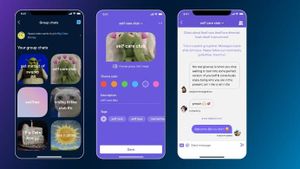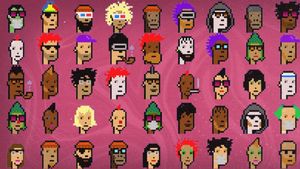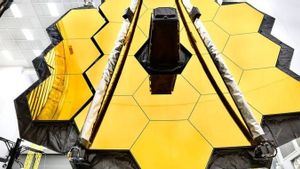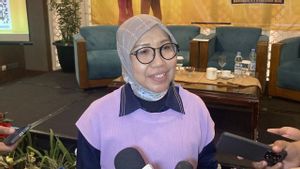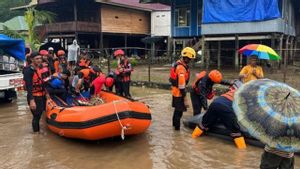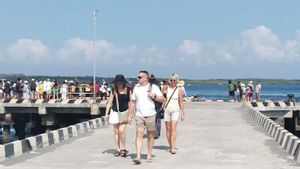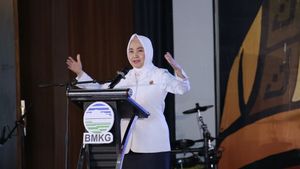JAKARTA - The situation which is still the same as last year, where the COVID-19 pandemic hit did not ignite the enthusiasm of the originators of new breakthroughs in exploring technology.
Although new variants of COVID-19 continue to arrive in the same year, many technological and scientific events have occurred recently. In fact, very rapid progress is present in 2021.
Now ordinary citizens can enjoy the view of Earth from space thanks to billionaires Richard Branson and Jeff Bezos as pioneers of spacecraft. They managed to take civilians flying into space.
Not only that, the astronauts who previously settled on the International Space Station (ISS) managed to grow chilies and vegetables there, as part of their research. So happy, they made delicious dishes from the harvest.
On the one hand, this year is quite a sad year because some people have to leave their analog TV broadcasts. The Ministry of Communication and Information (Kemenkominfo) requires all Indonesian citizens to switch to using digital TV in the Analog Switch Off (ASO) program.
However, the proudest thing is that Indonesia is now able to enjoy its fifth brand-new network, aka 5G, even though it is far behind other countries, with the presence of 5G, indicating that technology is increasingly developing in this country.
For more details, the following, VOI summarizes a number of events and developments in technology and science throughout 2021 and predictions for the following year.
Billionaire Duo Prints History of Space Travel
Right on Sunday, July 11, Branson and his space company, Virgin Galactic, successfully flew to the edge of space carrying two pilots Dave Mackay and Michael Masucci. There were also three other crew members in the cabin: Chief Astronaut Instructor Beth Moses, Principal Operations Engineer Colin Bennett, and Vice President of Government Affairs and Research Operations Sirisha Bandla.
The journey, dubbed the Unity 22 mission, also marks the start of the era of human space travel. Branson and the rest of the crew rode the spacecraft SpaceShipTwo aka VSS Unity for 11 minutes in space.
"I've been dreaming of this moment since I was a kid, but honestly nothing can prepare you to see Earth from space. Everything is magical," Branson said at a press conference.
The Unity 22 mission marks the fourth test flight into space for a vehicle and the first for Branson, who has been dreaming of this for 17 years.
Upon their return, Virgin Galactic opened reservations for anyone wishing to purchase a spacecraft ticket on a SpaceShipTwo. Virgin Galactic set a higher price of USD 450.000 or approximately IDR 6.4 billion, far higher than its previous price of USD 250.000 or approximately IDR 3.5 billion during its initial ticket sales offer last year. The ticket is a ticket per seat for one hour duration. Prices include training and space uniforms.
“As we strive to bring the wonders of outer space to a vast global population, we are excited to open the doors to new industry and consumer experiences,” said Virgin Galactic.
In this space tour, the company has three consumer offerings namely one seat, multi-seat for couples, friends and family, as well as full ticket purchases. According to Virgin Galactic's vice president of communications, Aleanna Crane, about 1.000 people have put cash in advance, including SpaceX co-founders Elon Musk, Tom Hanks, Lady Gaga and Justin Bieber.

Besides Branson, the second billionaire to have ventured into outer space is Jeff Bezos, founder of Amazon and Blue Origin. Despite being overtaken by Branson, Bezos' spirit is still burning.
Bezos was not alone on this flight. He was also accompanied by Mark Bezos, his brother, Wally Funk, an 82-year-old space pioneer of the space race, and Oliver Daemen, an 18-year-old Dutch student. Daemen is the son of a businessman who his father paid to become Blue Origin's first paid passenger.
The four, including Bezos, flew on the first crewed flight of his rocket, the New Shepard, on Tuesday, July 20. Branson's flight reached only 53 miles above Earth, while Bezos covered 62 miles, known as the space limit.
"Best day ever. My expectations were high and they were dramatically exceeded," Bezos said when he landed safely on Earth after 10 minutes and 10 seconds in the sky.
Bezos said the first manned flight was a step towards developing a fleet of reusable spacecraft for space tourism, which he claimed could cost up to $100 million.
After that success, Bezos returned to fly the eldest daughter of US astronaut, Alan Shepard, Laura Shepard Churchley on December 11, 2021. Churchley flew into space with another honorary passenger, Michael Strahan, former National Football League star and broadcaster of "Good Morning America".
Apart from these two, there were also four passengers who paid a very large amount. They are space industry executive Dylan Taylor, engineer-investor Evan Dick, venture capitalist Lane Bess and his son Cameron Bess.
It is predicted that in the following years, the two billionaires' spacecraft will continue to grow. The reason is, tickets for the Branson spacecraft alone already have around 1000 ticket holders now. Bezos, meanwhile, was reluctant to say how many tickets the company had sold. He just said that the demand was very high.
The International Space Station Becomes a Harvest Moon
In March earlier this year, ISS astronauts succeeded in planting Pak Choi's crops. Astronaut Michael Hopkins is seen in a photo showing a nearly mature Pak Choi (a type of mustard) plant on the space station.
NASA crews bring plants to the research ISS and are consumed by astronauts to provide them with nutrition on long-term missions, including exploring Mars. NASA has been exploring ways to grow food in space and assessing the challenges of space gardening at its Vegetable Production System (Veggie) facility.
Actually, this is not the first time they have experimented with growing vegetables, Hopkins failed several times to grow lettuce on the ISS. However, he did not give up so easily that Pak Choi's plants grew for the first time.

There have also been trials of previous plant seeds which have also produced some delicious food. Where the crew has been enjoying space-grown red lettuce and radishes. Not only that, in order to beautify the ISS, the astronauts also plant flowering plants, such as Zinnia.
Furthermore, on December 6, the astronauts on the ISS also returned to harvest chilies. This is the second hot pepper to be planted at the station, ending one of the most challenging experiments in growing crops in space to date.
Although on Earth it looks easy to grow chili, but the experiment of growing chili peppers according to astronauts on the ISS is much more challenging than any other crop. This is because chili is a flowering plant and takes 137 days to grow, compared to other plants which only require a month or two.
As before, chilies were grown on the ISS Advanced Planet Habitat as part of an experiment called Plant Habitat-04. The first batch of chilies was harvested last October 29 and turned into delicious tacos for the crew on the ISS.
One of the great advantages of growing chili peppers is that their spicy taste appeals to astronauts, who often request condiments such as hot sauce to make their food more appetizing.
Not only growing vegetables, the astronauts on the ISS are also experimenting with making cement in space and although it creates a slightly different microstructure than on Earth, this cement works.
The experiment, called the Microgravity Investigation of Cement Solidification (MICS), involves mixing cement powder with various additives and different amounts of water. In the last round of experiments, a mixture of tricalcium aluminate and gypsum showed interesting results.
In the future, this "space-made" cement mixture could be used to build stations on Mars or the Moon. Cement is used to make concrete, which has excellent protective properties against cosmic radiation. It was also strong enough to protect against meteorite impacts.
To make things easier, future explorations of Mars and the Moon could actually 3D print concrete structures made of lunar and Martian soil in a 3D printer similar to the Additive Manufacturing Facility currently on board the space station.
Sayonara to Analog TV, Welcome to the New Era of Digital TV
The Ministry of Communication and Information (Kemenkominfo) will soon migrate analogue to digital television (TV) or Analog Switch Off (ASO), which is scheduled to be completed on November 2, 2022.
For this transition, tube and LCD TVs can use a Set Top Box (STB) to get a digital television broadcast signal. The device is rumored to be distributed free of charge by the government.
However, before that, the Ministry of Communication and Information will implement three stages and a schedule for stopping analog television broadcasts. The Director General of Post and Information Technology at the Ministry of Communication and Informatics, Ismail explained that there were three stages, namely the first stage on April 30, 2022 which covered 56 regions and 166 regencies/cities, the second stage on August 25, 2022 in 31 regions and 110 regencies/cities and the third stage on November 2, 2022, covering 25 Regions and 63 Regencies/Cities.
"The process of determining and promulgating amendments to Ministerial Regulation Number 6 of 2021 concerning the new ASO schedule has been completed, so we can announce the ASO stages that we will carry out by November 2, 2022," said Ismail.
The areas experiencing the first phase of ASO are the islands of Sumatra, Java, Kalimantan, Sulawesi, Maluku and Papua. The second stage is South Sulawesi 5, Central Kalimantan 6, East Nusa Tenggara 2, DI Yogyakarta, West Java 1, Central Java 1, and DKI Jakarta. The final stages include Central Java 5, West Kalimantan 6, West Nusa Tenggara 5, Maluku 2, Central Sulawesi 3 and Papua 9.
The schedule and stages of ASO are in accordance with the Regulation of the Minister of Communication and Information Number 11 of 2021 concerning Amendments to the Regulation of the Minister of Communication and Information Technology Number 6 of 2021 concerning Broadcasting.
According to Ismail, the gradual implementation of ASO is a common practice in many countries. In fact, with this stage, stakeholders can prepare digital broadcasts as well as possible.
Furthermore, the Ministry of Communication and Informatics also appealed that during the ASO process, simulcast broadcasts would continue to run in order to provide opportunities for the public to adapt to digital broadcasts.
"We urge the simulcast broadcasts that have been running in almost all of Indonesia to continue to run to give the public the opportunity to adapt to digital television broadcasts," said Ismail.
SEE ALSO:
Indonesia has finally entered the era of super fast internet
The new 5G network is now in Indonesia, right on May 5, Telkomsel became the pioneer of the 5th generation network.
Now Indonesian citizens can enjoy Telkomsel's 5G network which is available at a number of points, starting from DKI Jakarta, Bandung, Solo, Surabaya, Medan, Batam, Makassar, Balikpapan, and Bali. Especially in DKI Jakarta, 5G Telkomsel is available in Alam Sutera, BSD, Kelapa Gading, PIK, Pondok Indah, and Widya Chandra.
The 5G network is present in the 2.3 GHz frequency band, has a width of 30 MHz which is held at 2300-2330 MHz. In addition, Telkomsel customers do not need to change their SIM card to get 5G service, the most important thing is that they have used the 4G network before.
The company says 5G speeds are 100 times faster than 4G. That way, the network certainly promises better download and upload speeds and a more comfortable experience for customers.
On the other hand, Telkomsel is not alone, there is also Indosat Ooredoo which has just expanded their 5G network in DKI Jakarta. This is the second city covered by Indosat Ooredoo's 5G network, after previously launching in the city of Solo, Central Java.
The coverage itself is around the National Monument (Monas), or the Indosat Ooredoo head office area on Jalan Medan Merdeka Barat, Central Jakarta and in several other areas of DKI Jakarta, Solo, Surabaya, Makassar and Balikpapan.
Not only for customers, 5G Indosat Ooredoo is also intended for industrial or business purposes. Of course it is in the industrial area of Karawang, West Java. Indosat Ooredoo operates a 5G network in the 1.800MHz or 1.8GHz frequency band with a 20MHz bandwidth in the 1.837.5MHz to 1,857.5MHz range.
Unfortunately, 5G adoption in Indonesia is still minimal and limited, this is due to several factors such as the availability of frequency spectrum.

"For us to know, the biggest obstacle in 5G is the availability of adequate frequency spectrum. Therefore, the frequency spectrum farming and refarming program is the main concern of the Ministry of Communication and Information," said Minister of Communications and Information, Johnny G. Plate, during the event Digitizing Indonesia: Retrospection of Kominfo 2021 and Outlook 2022, in Jakarta recently.
Johnny stated that the frequency refarming process is not an easy job, because the spectrum users have to move to another frequency.
"Well, this requires intense communication and it will have implications on the commercial side. If you move, there will be costs that will not be small," added Johnny.
Therefore, Johnny said that Indonesia must have the availability of frequency spectrum at all levels, be it 2.1 Ghz, 2.3 Ghz, 2.6 Ghz, 3.3 Ghz and 3.5 Ghz.
At the same time, Johnny explained that apart from the issue of spectrum availability, currently not all of the handsets or smartphones that are present support the 5G network. Therefore, Johnny asked for cooperation from smartphone manufacturers.
"Not all of our cellphones have 5G facilities. The software is not necessarily 5G. So, we also have to work with companies that make cellphones. So it is on the operator side to prepare the infrastructure, from the government side in providing spectrum and on the user side to prepare cellphones," concluded Johnny.
The English, Chinese, Japanese, Arabic, and French versions are automatically generated by the AI. So there may still be inaccuracies in translating, please always see Indonesian as our main language. (system supported by DigitalSiber.id)



